Even in the age of instant messaging, business letters still carry weight. They show professionalism, structure, and intent. But for many, formatting one properly can feel confusing or outdated. Should you indent? What goes where? Let's break it down simply, so you can write letters that get taken seriously.
Part 1: Understand the structure of a business letter
A well-structured business letter ensures your message comes across clearly and professionally. Whether you're applying for a job or writing to a client, following the right format helps establish credibility and avoid confusion. Below are the seven essential components of the format of a business letter:
The 7 Key Components:
Sample Layout:
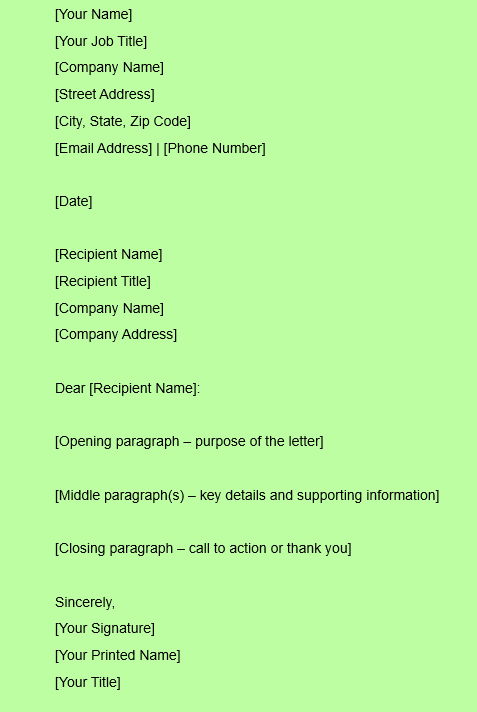
This format of business letter template helps ensure nothing is missed, whether you're writing a formal job application or a complaint to a supplier.
Part 2: Two main business letter formats
There isn't just one format of business letter; there are two main styles professionals use. Choosing the right one depends on your audience, purpose, and preference. Let's explore both formats so you can pick what suits your message best.
Block Format (The Modern Standard)
Block format is the most common structure in professional settings today. It's simple, clean, and easy to read, making it ideal for most business situations.
Key Features:
All text is left-aligned, with no indentations at all.
Use single-spacing throughout the letter.
Leave one blank line between paragraphs.
No need for tabs or extra spacing tricks, everything follows a clean margin.
Example Layout:
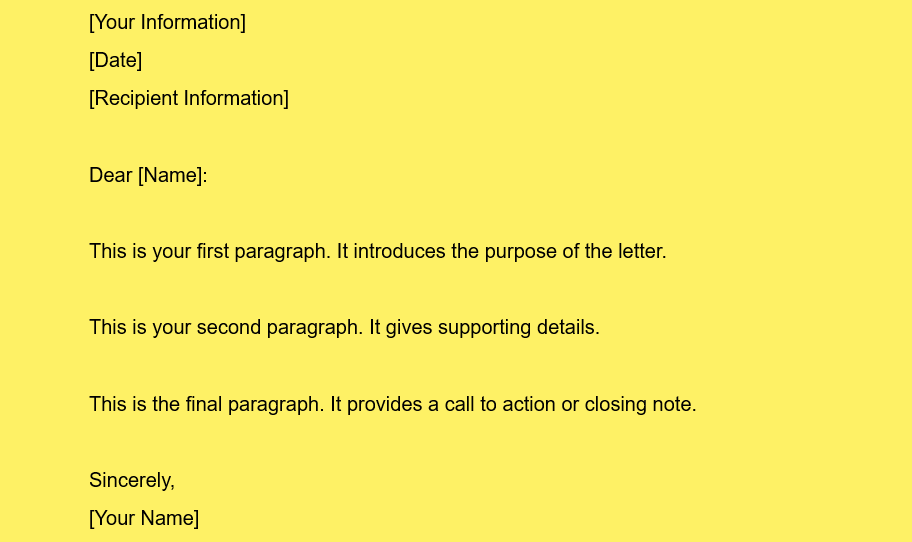
Block format of a formal business letter is widely accepted in English-speaking business environments for its no-frills professionalism.
Indented Format (A More Traditional Choice)
Indented format is considered more old-school, but it's still used in conservative industries like law, academia, and formal international correspondence.
Key Features:
Sender's address, date, and salutation are oftencenter-aligned or slightly right-shifted.
Each paragraph begins with an indentation(usually half an inch).
Still single-spaced, but visually it feels more classic and elegant.
Example Layout:
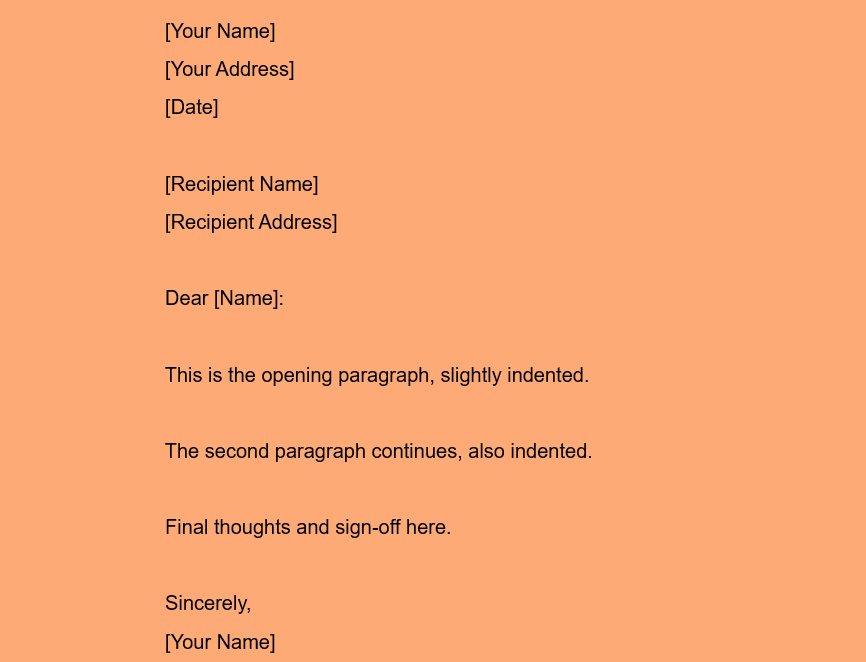
This format of business letter model might feel dated, but it adds a level of formality that's still appreciated in specific settings.
Choosing between block and indented styles is more about youraudience and tone. If unsure, go with block, it's universally acceptable.
Part 3: Craft clear and professional content
Once you've chosen the right format of business letter, the next step is writing content that's polished, purposeful, and easy to follow. A well-written letter doesn't ramble—it communicates with clarity and confidence.
Structure of the Body:
Opening Paragraph – State Your Purpose Clearly
Start with why you're writing. Whether it's a job application, inquiry, or complaint, make it clear from the beginning.
Example: "I am writing to express my interest in the marketing assistant position listed on your website."
Main Paragraph(s) – Support with Details
This is where you provide context, supporting facts, or requests. Stay on topic, use concise language, and keep each paragraph focused on a single idea.
Closing Paragraph – End with Action or Gratitude
Summarize your request or express appreciation. Add a call to action, like requesting a meeting, or simply thank the reader for their time.
Example: "I would welcome the opportunity to discuss this further. Thank you for your consideration."
Tone Tips:
Always maintain a formal and respectful tone.
Avoid slang, emojis, and overly casual phrasing.
Write in full sentences, and limit the use of contractions (e.g., use "I am" instead of "I'm").
Even the best structure won't work if the tone is off. Think of your letter as a handshake in writing, firm, respectful, and direct.
Part 4: Refine your language with Toolsmart's Paraphrasing Tool
Even with the perfect format of a business letter and clear content, your writing can sometimes feel too blunt, too casual, or just slightly off-tone. That's where Toolsmart's Free Paraphrasing Tool comes in, a helpful assistant that helps transform your rough draft into polished, professional English.
Why use a paraphrasing tool for business letters?
It helps non-native speakers or early-career professionals refine their tone.
You can save time revising awkward sentences into formal phrasing.
It ensures your letter maintains a clear and respectful tone without losing your original message.
Example:
Original: "I'm writing to ask about the job."
Refined: "I am writing to inquire about the position."
The second version is smoother, more professional, and fits better with the overall format of a formal business letter.
Steps to Use Toolsmart's Paraphrasing Tool:
Step 1: Visit Toolsmart Paraphrasing Tool
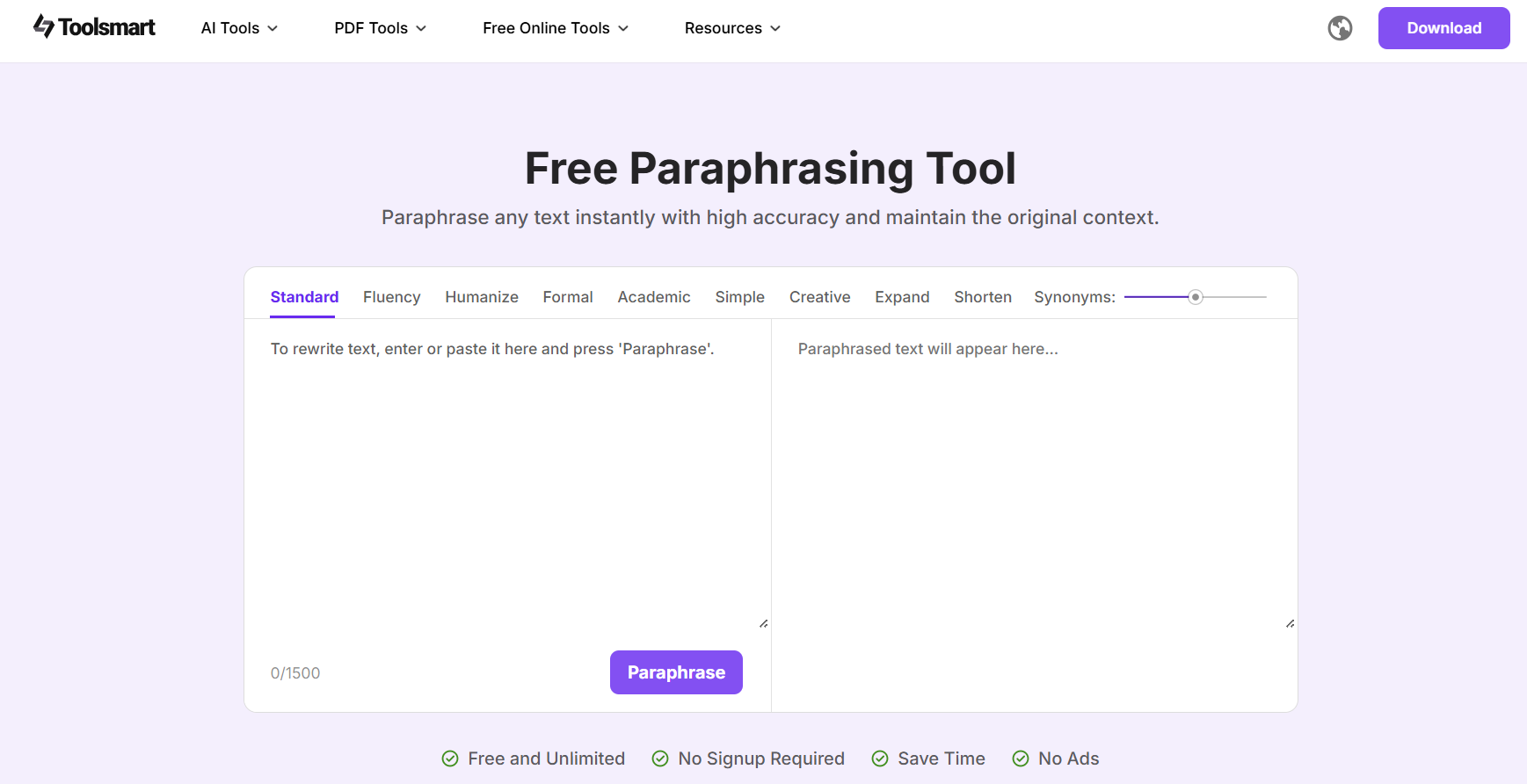
Step 2: Copy and paste your draft sentence into the input box
Step 3: Choose the "Formal" tone from the dropdown options
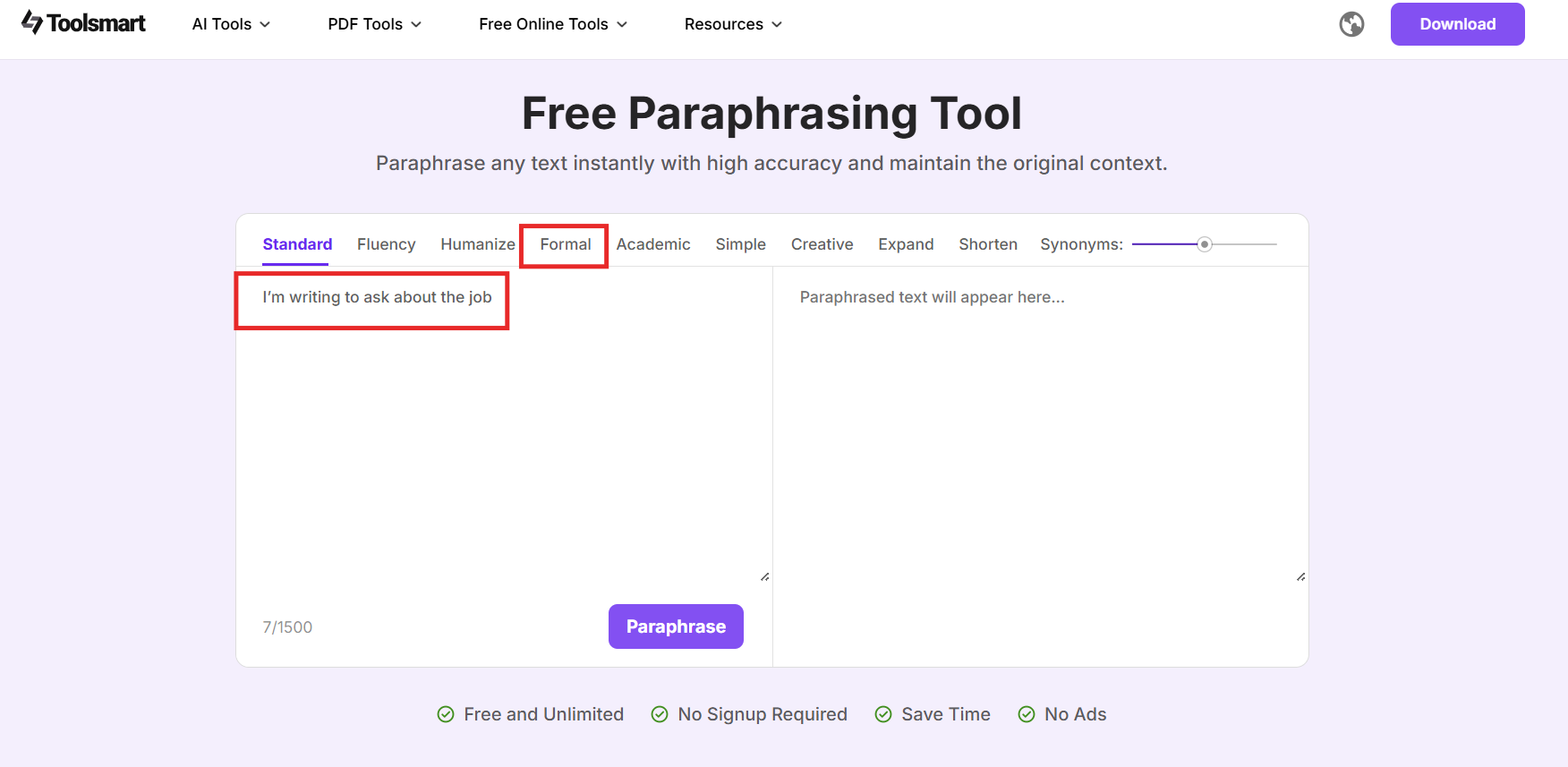
Step 4: Click "Paraphrase" and wait for the AI to refine your sentence
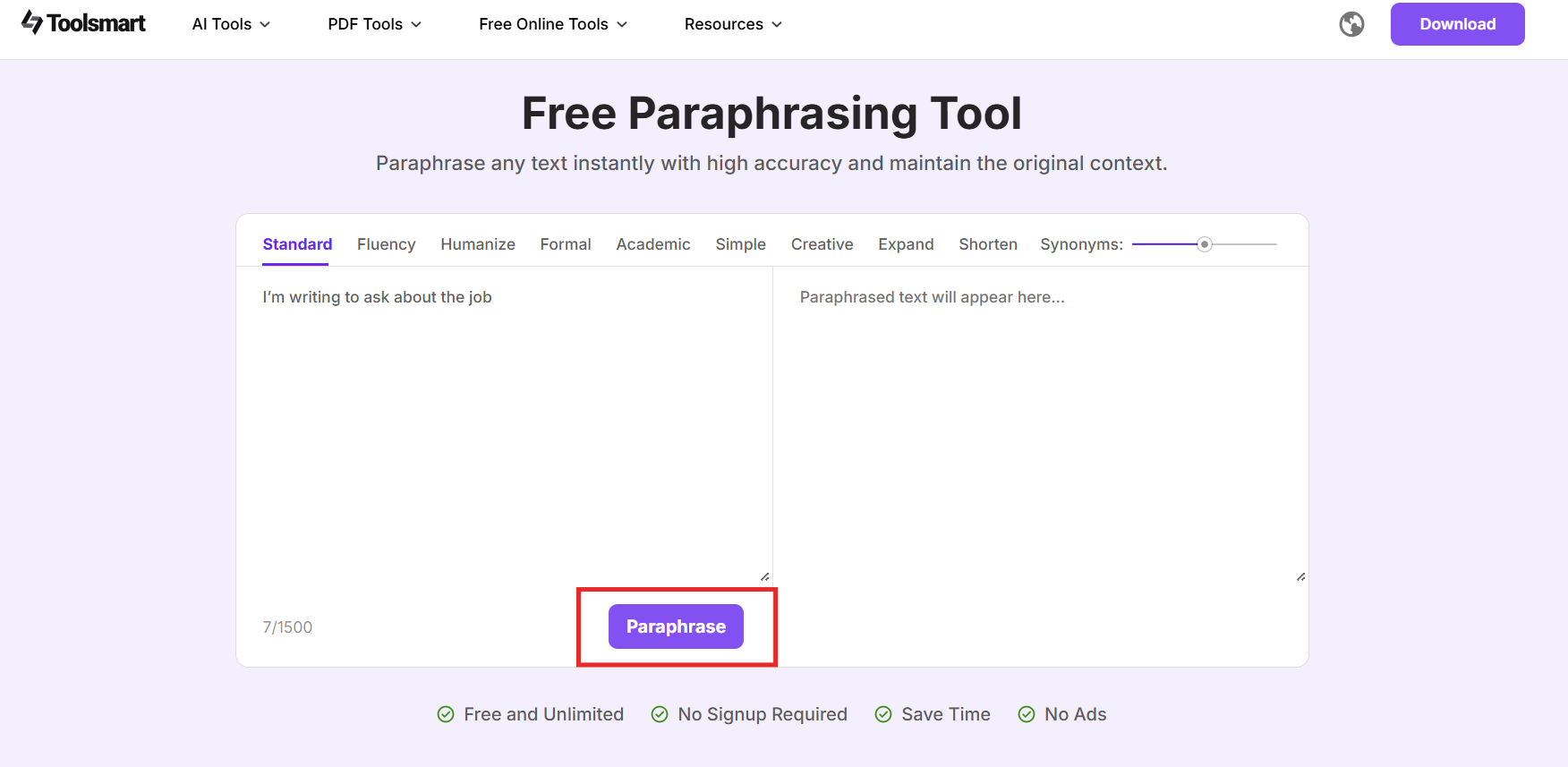
Step 5: Review the result and adjust if needed to match your intent
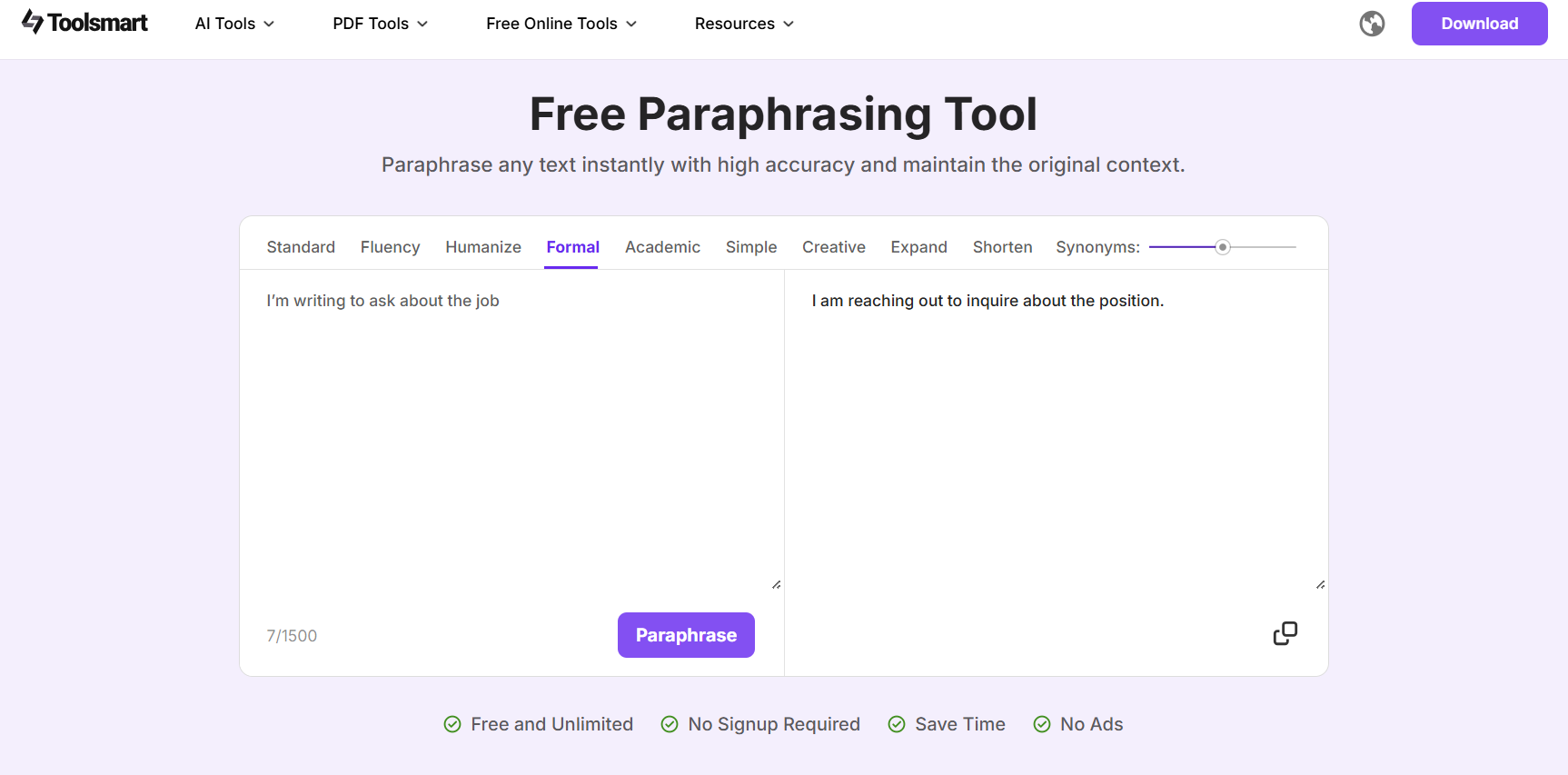
This tool is especially helpful when writing multiple letters, client emails, or proposals, where tone consistency is key.
Tip: Even experienced writers benefit from a second opinion. Toolsmart ensures your format of business letter in English feels fluent, natural, and confidently written.
Part 5: Review, edit, and finalize your business letter
You've structured your content and refined your language, but don't hit "send" just yet. Every formal letter should go through a final polish. Small mistakes can damage the professional impression you've worked so hard to create.
Final Review Checklist:
Check the format
Make sure you've followed either the Block or Indented format correctly. Double-check spacing, alignment, and margins.
Fix spelling and grammar errors
Use Grammarly or a similar tool to catch typos and awkward phrasing.
Maintain a consistent tone
Read your letter from start to finish to ensure the tone stays formal and professional throughout. Avoid any abrupt changes in style.
Review clarity and flow
Ask: Does each paragraph have a clear purpose? Are transitions smooth?
Proofread out loud
Reading your letter aloud helps you spot confusing or overly long sentences.
Get a second opinion
If possible, ask a trusted colleague to review your letter.
Bonus Tip:
Revisit Toolsmart's Paraphrasing Tool during this stage. Use it to polish final phrases or improve flow in spots that still feel a bit off. Whether you're trying to rephrase a closing sentence or soften a direct request, this tool helps you sound confident without sounding robotic.
A final edit might take 5 extra minutes, but it could make the difference between being taken seriously and being overlooked.
FAQs
Q1: Can I use email format for a traditional business letter?
No. Email and traditional business letters have different formatting rules. A formal business letter requires elements like the sender's address, recipient's address, salutation, and a structured layout, features not typically used in emails.
Q2: What font and size are appropriate for a business letter?
Stick with professional fonts like Times New Roman, Arial, or Calibri, using size 11 or 12. These fonts ensure readability and maintain a formal tone.
Q3: Can I use contractions in a business letter?
It's best to avoid contractions (e.g., use "do not" instead of "don't") to maintain a formal, respectful tone. That said, some industries might tolerate a slightly relaxed style; use your judgment based on your audience.
Q4: What should I do if I need to send multiple copies of the same business letter?
Use the "cc:" (carbon copy) notation at the bottom of the letter to indicate who else is receiving a copy.
Q5: How can Toolsmart's Paraphrasing Tool improve my business letters?
It rewrites awkward or overly casual sentences to sound clear, formal, and professional, without changing your intended meaning. It's especially helpful for polishing tone and boosting confidence in your writing.





